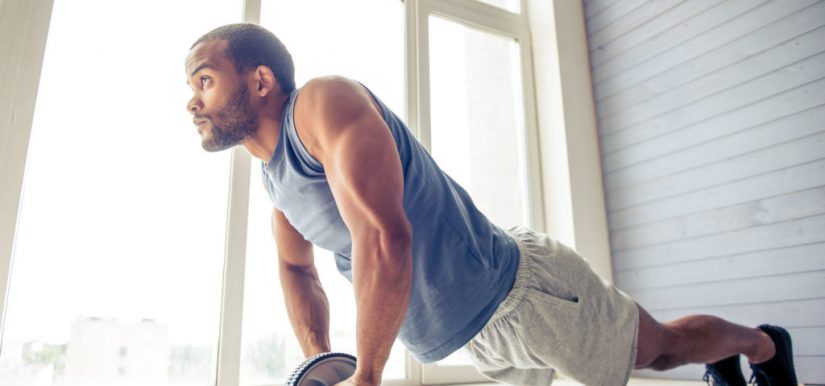Having a newborn at home = I’ve been waking up on the wrong side of the bed lately. A lot. I’m cranky AF and my brain waves aren’t firing on all cylinders this morning so you can blame this lame introduction on that.
Cool?
Awesome. Lets discuss abs. Specifically, lets discuss one of the more common ab exercises out there: the abdominal rollout.

The Abdominal Rollout: A Complete History (But Not Really)
I’d like to sit here and pizzaz you with some interesting factoids and trivia about the abdominal rollout, like, say, I don’t know, its roots can go all the way back to Mesopotamia and that every male had to perform strict repetitions for 17 hours straight before he was allowed to mate. Maybe the History Channel can back me up on that one?
Who knows, for all I know some guy named Phil was the first to perform the exercise while training in his basement in 1968 while jamming to Hendrix. Phil was cool as shit.
Either way, all I can really tell you is that it’s a staple exercise that trains the anterior core musculature – upper and lower rectus regions in addition to the internal and external obliques – and has long been a “go to” exercise for anyone looking to shred their mid-section.
Copyright: max5799 / 123RF Stock Photo
Specifically the abdominal rollout is an excellent variation that trains ANTI-EXTENSION, and, well, many people tend to miss the boat in this regard.
I see a lot of common mistakes when I watch trainees perform this exercise. In fact, most would be better off pumping the brakes a little bit and mastering something like an RKC plank first.

RKC Plank = a plank (albeit learning appreciate tension).
The set-up is more or less the same a regular ol’ plank, except here you’ll want to flex everything – your abs, glutes, quads, eyelids, everything.
An important cue I use when teaching the RKC plank is to tell the person doing it to pretend as if they’re trying to drag their elbows towards their toes. When done right, it increases the “holy cow, this is really hard” factor by a large margin.
Also, when done right, 10 seconds will feel like torture.
But I’m getting a little off-track. What are those common mistakes of the rollout I was referring to above? The two most common are:
- People falling into excessive lumbar extension (<– remember: the rollout is an exercise that helps train anti-extension; it defeats the purpose of the drill if you allow your lumbar region to “fall” into extension). The idea should be to maintain posterior pelvic tilt of the pelvis throughout.
- Not allowing the hips to follow the shoulders.
In Case You’re Too Important to Watch the 2-Minute Video Above
1. I like to cue people to start the exercise in a bit more of a lumbar flexed posture (PPT). Relax, it’s unloaded flexion, you’ll survive. By doing so, most will end up in spinal neutral as they draw closer to the floor.
2. My triceps look jacked in that video.
3. Oftentimes as people break toward the floor their shoulders will lead and the hips will tend to lag behind. A cue that often works for me is to tell the person to pretend there’s a rope or chain connecting their hips and shoulders and that the shoulder are “towing” the hips behind them. They should move simultaneously.
Address those two things and technique will clean up nicely.
How About Progressions?
Assuming you’re already pretty good at the standard rollout, what are some ways we can progress the exercise?
Some less sexy alternatives would be:
- Add a pause at the bottom.
- Use a slower tempo on the way down and up. Think: three seconds down, pause, three seconds up.
We all know you’re going to skip those however, so maybe consider these options?
Level 1: This Is Kinda Cool, I Guess – Elevator Ab Wheel Rollout
Here, the idea is to include some pitstops or “speed bumps” along the way to make the movement more challenging and to increase time under tension.
With the Elevator Rollout I’ll tell people to rollout to three different lengths:
- 1/2 way out, then back.
- 3/4 way out, then back.
- Full ROM, then back
- THAT’s one rep.
Aim for 5-6 repetitions (which is really 15-18 repetitions when you count all the additional stops).
Level 2: Alright, Now We’re Talking – 2-Way Ab Wheel Rollout
All we need to do to make something a little more challenging is to add a change of direction. With the 2-Way Ab Wheel Rollout the idea is to alternate between veering off to the left and to the right. But, really, you can add as many directions as you want. And, if you’re really feeling frisky you can combine this with the elevator variation above.
I like to shoot for 6-8 repetitions per direction with this one.
Level 3: Ohhhhhhhhhhhh, Snap – Band Resisted Ab Wheel Rollout
To up the ante even more we can add resistance in the form of a band. With this variation I wrapped two bands around the corner of a squat rack and wrapped the other ends around each handle of the abdominal wheel.
The band will “assist” with the yielding/eccentric component, but you will need to fight and overcome the concentric portion. It’s a pretty nasty progression, so don’t take it lightly.
Aim for 8-12 repetitions.
Level 4: “Whoa, I Know Kung-Fu” – Standing Band Resisted Barbell Rollout
^^ Bonus points for The Matrix reference.
Admittedly, this isn’t that baller…but it’s a nice variation for those who aren’t quite able to perform a strict standing rollout (which is next level Jedi shit). With this variation you have to overcome the band as you roll out, however on the way back the band will accommodate or assist you back up to the starting position. Pretty nifty.
Aim for 5-8 repetitions.
And that’s that. I hope those tips to clean up technique help and made sense, and I also hope you now have a few new exercises to try.






